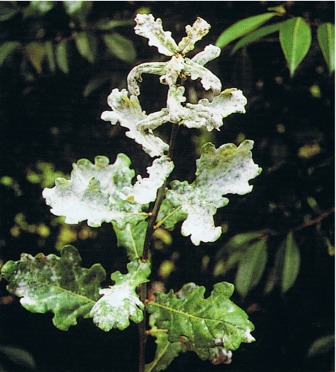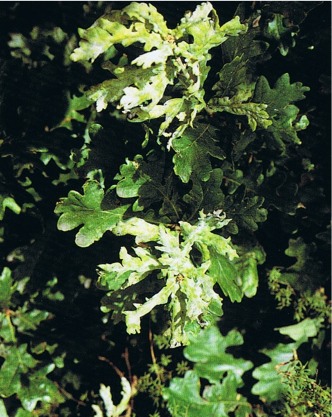PESTS AND DISEASES OF FORESTRY IN NEW ZEALAND
Oak powdery mildew caused by Microsphaera alphitoides
Scion is the leading provider of forest-related knowledge in New Zealand
Formerly known as the Forest Research Institute, Scion has been a leader in research relating to forest health for over 50 years. The Rotorua-based Crown Research Institute continues to provide science that will protect all forests from damage caused by insect pests, pathogens and weeds. The information presented below arises from these research activities.
From Scion publication An Introduction to The Diseases of Forest and Amenity Trees in New Zealand,
Forest Research bulletin 220, G.S. Ridley and M.A. Dick 2001
Species:
Microsphaera alphitoides (Ascomycete)
Common name:
Oak powdery mildew
Country of origin:
Northern Hemisphere
Host(s):
Castanea crenata, C. sativa, Platanus x acerifolia, P. orientalis, Quercus faginea, Q. petraea, and Q. robur.
Symptoms:
A powdery, white coating of hyphae and conidiospores forms on the surface of young twigs and leaves (Fig. 45). In severe attacks the leaves shrivel, turn brown, and may be caste prematurely, particularly on young trees or on regrowth after pruning.
Disease development:
The fungus overwinters as mycelium in the dormant buds. The mycelium grows and infects the expanding leaves (Fig. 46) in the spring and quickly begins to sporulate. The conidiospores are wind-dispersed and cause further infection throughout the spring and summer. Optimum spore germination occurs between 20° and 23°C at a relative humidity of 76-96%.
NZ distribution:
Known from throughout New Zealand.
Economic impact:
Although it has caused nursery mortality in Europe, in New Zealand oak powdery mildew is only an aesthetic problem.

Fig. 45: Powdery mildew on young leaves of Quercus robur caused by Microsphaera alphitoides
Control:
In European nurseries control has been achieved with colloidal and wettable sulphur, dinocarp, and benomyl.
References:
Dingley 1969; Gilmour 1966; Hewitt 1974; Pennycook 1989; Phillips & Burdekin 1982; Smith et al. 1988; Strouts & Winter 1994.

Fig. 46: Deformed young leaves of Quercus robur caused by Microsphaera alphitoides
This information is intended for general interest only. It is not intended to be a substitute for specific specialist advice on any matter and should not be relied on for that purpose. Scion will not be liable for any direct, indirect, incidental, special, consequential or exemplary damages, loss of profits, or any other intangible losses that result from using the information provided on this site.
(Scion is the trading name of the New Zealand Forest Research Institute Limited.)

 Farm Forestry New Zealand
Farm Forestry New Zealand

